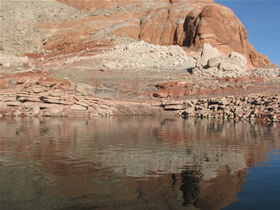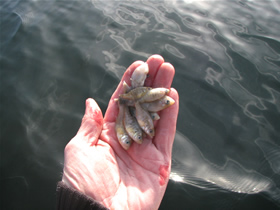|
||
|
|
Lake Powell Predicts Good March FishingBy Wayne Gustaveson
The best choice of fishing location is near aquatic weed beds and tumbleweed piles that are near deep water. Bass and stripers are holding quite consistently at 30-foot depths. They come shallower to feed and drop back over the ledge to rest. Find a spot with cover and deep water in near proximity and chances of finding willing fish increases. Good coves with lots of cover in the backs of shallow canyons will not be occupied until water warms to 57-60 degrees. Look for cover on the edge of deep water for best results. Tumbleweed piles are not forgiving when crankbaits or spoons get tangled in the branches. Weedless lures are a necessity and slow movement is the best presentation. Spinner baits fill the need as do suspending crankbaits – if the bait can be fishing along the brush tops instead of in the middle where snags await. Weedless baits like Texas-rigged senkos with no weight are perhaps the best lures to settle into the weed pockets without hanging up. On my outing this week I found slow fishing. I was able to catch some stripers that were actively searching for small fish along the 20- foot deep margin of a weed bed. They hit a spoon quickly and repeatedly and then were gone. Active stripers are moving quickly and hard to keep in casting range.
I suspect without fishing pressure this winter, stripers have either gone dormant or actively chased sunfish in weed beds. In either case, the appeal of bait is lessened. On the bright side, warming of a few more degrees will increase fish metabolism and need to feed. March should be good fishing with largemouth the prime target. Isolated tumbleweed pockets in sunny coves with deep water near by will be the best location. Stripers will be in slightly deeper water but very near the bass water. Bonus walleye will be in the same proximity. All are eating sunfish that hide in the thickest cover available. Remember to protect Lake Powell from the threat of invading quagga mussels that have been found in the lower Colorado River. Before launching in Lake Powell inspect your boat for the presence of adult mussels on the hull, motor or trim tabs. Kill them by washing with scalding hot water. |
|
 March
2007
March
2007 By the end of February, water temperature had crept back into the 50s following a few warm windless afternoons, but there is much more warming needed to really get fish going. Right now game fish are feeding sporadically. Catching is hit and miss.
By the end of February, water temperature had crept back into the 50s following a few warm windless afternoons, but there is much more warming needed to really get fish going. Right now game fish are feeding sporadically. Catching is hit and miss.  When we tried anchovies in the vacated area, it was as if the stripers had forgotten all about bait. We did not turn a fish on anchovies.
When we tried anchovies in the vacated area, it was as if the stripers had forgotten all about bait. We did not turn a fish on anchovies.